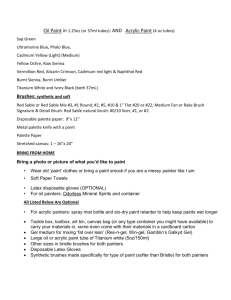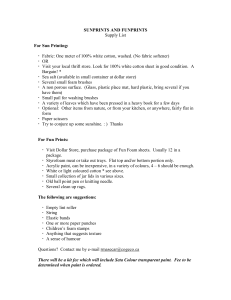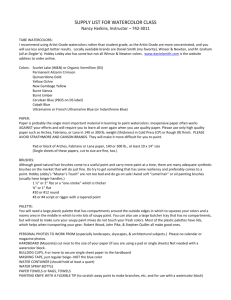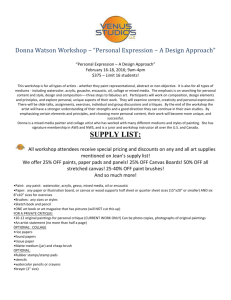Grade 3 History and Art collaboration
advertisement
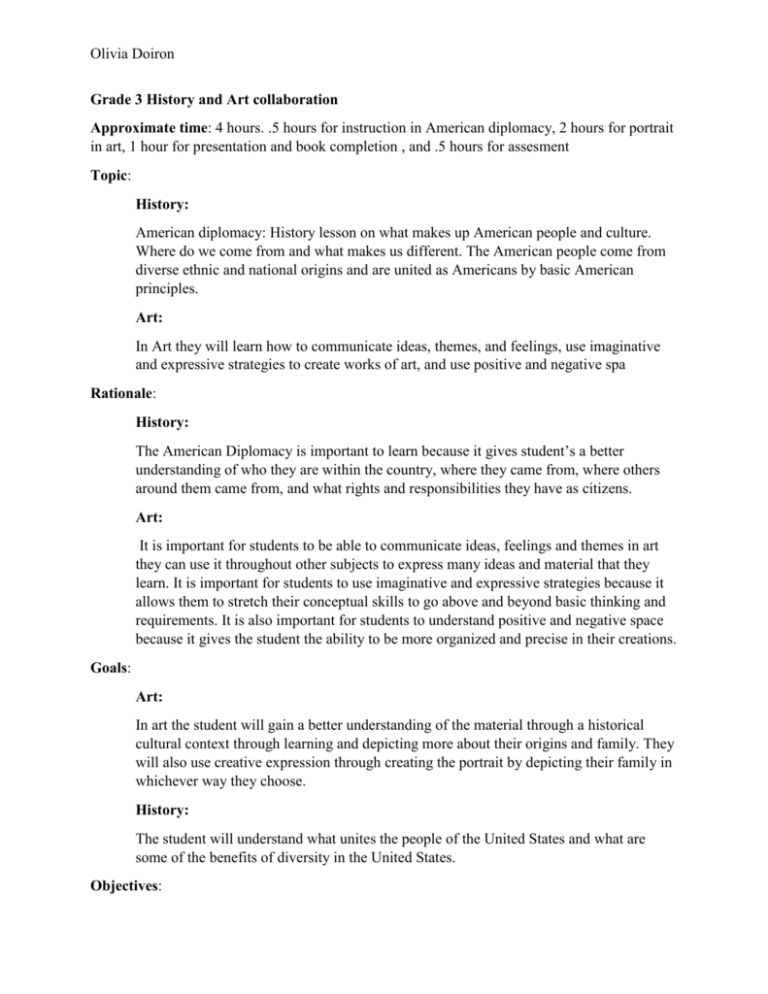
Olivia Doiron Grade 3 History and Art collaboration Approximate time: 4 hours. .5 hours for instruction in American diplomacy, 2 hours for portrait in art, 1 hour for presentation and book completion , and .5 hours for assesment Topic: History: American diplomacy: History lesson on what makes up American people and culture. Where do we come from and what makes us different. The American people come from diverse ethnic and national origins and are united as Americans by basic American principles. Art: In Art they will learn how to communicate ideas, themes, and feelings, use imaginative and expressive strategies to create works of art, and use positive and negative spa Rationale: History: The American Diplomacy is important to learn because it gives student’s a better understanding of who they are within the country, where they came from, where others around them came from, and what rights and responsibilities they have as citizens. Art: It is important for students to be able to communicate ideas, feelings and themes in art they can use it throughout other subjects to express many ideas and material that they learn. It is important for students to use imaginative and expressive strategies because it allows them to stretch their conceptual skills to go above and beyond basic thinking and requirements. It is also important for students to understand positive and negative space because it gives the student the ability to be more organized and precise in their creations. Goals: Art: In art the student will gain a better understanding of the material through a historical cultural context through learning and depicting more about their origins and family. They will also use creative expression through creating the portrait by depicting their family in whichever way they choose. History: The student will understand what unites the people of the United States and what are some of the benefits of diversity in the United States. Objectives: Olivia Doiron History: The students will be able to identify what separates them within the American culture as well as what unites them as Americans. They will understand their origins, the definition of freedom, republic, democracy, voting, and citizenship. They will know the benefits of diversity which are food, clothing, and music. Art: They will understand how to depict themselves and their ideas in a creative way through drawing, using positive and negative space. They will be able to depict feelings, thoughts, and ideas. Vocabulary: History: Republican form of government: A representative democracy Benefits of diversity: Food, clothing, and music Life, liberty, and the pursuit of happiness are privileges that people are born with and that cannot be taken away Equality under the law means that all people are treated fairly Democracy is a form of government in which all eligible citizens participate equally— either directly or indirectly through elected representatives—in the proposal, development, and creation of laws Freedom: the power or right to act, speak, or think as one wants without hindrance or restraint. Art: Positive space: the area or part of a painting's composition that the subject occupies Negative Space: the space between objects or the parts of an object Introduction: I will tell the class that we are going to create a class book that tells the story of each of our families. I will tell them that it will show where we all come from and how being Americans brings us together. I will show them my own family portrait and explain how I drew each flag from my origins, each family member, the food we eat, and the holidays we celebrate. I will tell them that we are going to learn how to depict our ideas and feelings and show where we come from through artistic portraits. I will also explain that we will learn where we come from and what unites us. Olivia Doiron Procedures: History: The students will go home and interview their parents with the following questions: What countries did we come from? What holidays do we celebrate? What religion do we practice? What foods are specific to our family? Where are your parents from? Art: Then they will draw a portrait of their family using large white sheets of paper, and acrylic paint. They will paint each family member and depict each answer to each interview question within the picture using their own creative ideas however they feel is the best way to represent the idea. They will be instructed to be creative and the teacher will explain positive and negative space. The art teacher will show the picture of a black tree surrounded by white background as an example. The students will be encouraged to acknowledge each positive and negative space in their own creations. History: The students will gather back in the classroom with their portrait and present their family to the class. Then the pictures will be bound together with string and a lesson will be taught on what makes each of us American. A sheet with vocabulary words will be handed out. The teacher will read a book on America, such as The Children’s Book of America by William J. Bennett, to the class and then the class will discuss together what unites us as Americans. The teacher will ensure that the vocabulary words are addressed such as a republic form of government, voting, rights, freedom, independence, and democracy will be addressed. The class will come up with words that describe what it means to be American. The teacher will paint the words that are said on another large sheet of paper. This sheet will serve as the last page in the book. Closure: History: The students will write a paragraph about the differences they noticed between the classmates families after viewing the artwork. They will then write how they see that Americans are united. This should include some (at least three) of the vocabulary words that were covered in the lesson. Art: The students will look at the artwork of the other students. They will give positive feedback on how the students expressed their ideas and how the students used positive and negative space. Clean-up: The students will be responsible for using the last ten minutes of class to put away all paint brushes, paint, water cups, plates, and any extra paper or materials. Each table will have Olivia Doiron their own set of paint and brushes and each table is responsible for making sure that all of their materials are put away. Assessment: History: The students will be assessed of understanding of their own origins by examining their artwork through their presentation. Students will be assessed for understanding of what makes an American by reading their closure paragraphs. There should be at least three of the vocabulary words that were learned in the lesson used in the paragraph. The visual evidence of their work will be used to assess the students’ knowledge of the skills of creative expression and positive and negative space in the art classroom. Their performance of the concepts should be obvious within their artwork. There should be equal positive and negative space. The artwork should show creativity and express at least three ideas of the student’s specific family origins. Art: The students will be evaluated based on how much effort they put into their work. Did they seem to be diligently on task. Their projects will be looked at for completion and creative expression of their family values as well as positive and negative space. Materials: Students need: notebook paper, the ability to interview parents, pencil, and eraser History teacher needs: Big paper, acrylic paint, paint brushes, plastic cup, hole puncher, string Art teacher needs: large white paper, acrylic paint, brushes, plastic cup SOLs: History: STANDARD 3.11 Life, liberty, and the pursuit of happiness are privileges that people are born with and that cannot be taken away. Equality under the law means that all people are treated fairly Some basic principles held by American citizens include the rights to life, liberty, and the pursuit of happiness; and equality under the law. What are some basic principles commonly held by American citizens? Art: GRADE 3 VISUAL ARTS The student will use the following in works of art: Olivia Doiron (3.7) Space—positive, negative (3.4) The student will use imaginative and expressive strategies to create works of art. (3.6) The student will create works of art that communicate ideas, themes, and feelings.
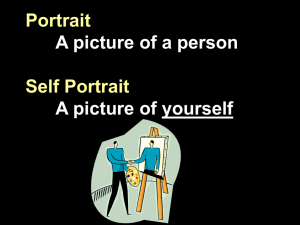

![[Agency] recognizes the hazards of lead](http://s3.studylib.net/store/data/007301017_1-adfa0391c2b089b3fd379ee34c4ce940-300x300.png)

